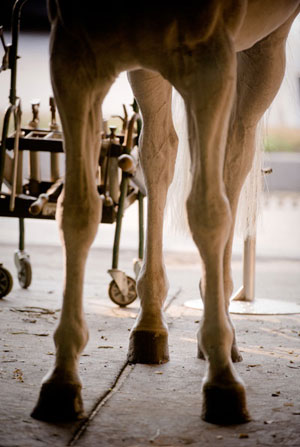Barefoot or shod: what’s right for YOUR horse?

Hello Dr. Gray. I am writing today in regards to shoeing. There seems to be a trend towards riding barefoot. A huge article just came out in Dressage Today magazine about Shannon Peters taking a few of her top performers barefoot. I am intrigued by this concept because I have been taught that horses always need shoes for added stability. The thought of riding without shoes is equal to the sin of jumping without a helmet. Should my training level dressage gelding go barefoot? What are the medical ramifications of this? How long will his hooves take to adjust to the transition? What can I do to ease the transition? If barefoot, is he more at risk for tendon injuries, laminitis and other crippling injuries? Thank you as always Dr. Gray. Your support along with the SmartPak family has aided me tremendously!
– MP from California
A great question like this deserves an equally great answer, so I’ve “turfed” this to Danvers Child, the expert farrier who is our go-to-guy for all things related to hooves! BTW, my 3rd level gelding is barefoot for half the year and shod in front the other half. – Dr. Gray
Dear MP,
I was pleased with the balanced view presented in the article you reference. Too often, we see discussions of this type take on a polarizing nature, where hoof care professionals belittle each others’ methods, and somewhere along the way, the discussions simply derail, assume an argumentative tone, and adopt a focus of “my way is the right way” rather than focusing on what’s best for the horse.
Subsequently, it was refreshing to see my colleague Pete Ramey’s thoughtful comments summarized as “ignore extremists on both sides and consider what’s needed for the individual horse.” It’s a viewpoint I share in my farrier practice and in my own horse-keeping, with both of them averaging about 50% shod and 50% barefoot. The decisions aren’t generic, and they have to center upon each horse and doing what’s best for that horse.
Admittedly, what an individual practitioner determines as being “best” generally comes down to an opinion, and our opinions tend to stem from our backgrounds, our experiences, and our comfort zones. Ultimately, our nature is to promote and practice what we know. If your knee is injured, a surgeon is going to think about surgery, a chiropractor is going to think about adjustment, and a homeopath will likely suggest organic remedies. Ideally, however, each of those practitioners will be open to and knowledgeable about alternative treatments and approaches and will judge your situation according to your unique and individual needs rather than by providing generic answers and treatments.
And that’s what good hoof care providers do; they assess the entire situation and attempt to meet the individual and specific needs that are uncovered through their full assessment. Subsequently, I admit now that I do not have enough specific information to tell you whether your horse can go barefoot or not. I can tell you that, assuming there are no serious issues omitted in your general description, you should have no concerns about a transition to barefoot resulting in the major problems you mention: “tendon injuries, laminitis, and other crippling injuries.” Likewise, I can give you some general areas of consideration that should help guide your decision making and your discussions with your hoof care provider as you make choices about what’s best for your horse. With your gelding, and with all horses, the decision-making keys related to trimming vs. shoeing are twofold and revolve around:
1.) Understanding the base reasons for applications of shoes, which are limited, and
2.) Examining the variables that confound the issue, which are virtually unlimited.
There are three basic reasons for shoeing: to protect the foot, to address traction concerns, and to alter or enhance gait. While the reasons are limited, the discussions associated with those reasons are more involved than I can elaborate upon in this response. And to examine the variables that compound and confound the issue, one would have to write a weighty textbook. In brief, however, the variables fall into the basic considerations we deal with in all horse-keeping situations: over-riding concerns such as environment, climate, and genetic makeup, and situation-specific concerns such as age, terrain, and activity level, as well as considerations of disease, weakness, or injury.
Your concern about “transition” is vitally important. Unfortunately, it’s a common belief that transition involves a period of lameness or dis-ease. And I firmly believe that these elements should not be accepted. For me, transition means that you make wise decisions about when you’re going to remove shoes and what you’re going to expose your horse to (usage level, terrain choices, etc.) while he is adjusting. Basically, the transition should be about how you as a care provider prepare for and deal with altering your horse-keeping practices; it should never be about how much lameness and discomfort you’re willing to accept or how long you’re willing to accept it.
Ultimately, choosing to go without shoes requires as much, if not more, of a commitment than going with shoes. Again, I think the Dressage Today article did a good job of making it clear that Shannon Peters wasn’t simply pulling shoes and giving her horses a trim. Instead, her decision involved altered turnout, increased frequency of maintenance, fitting and re-fitting of boots, and numerous other horse-keeping choices, many of which require daily maintenance.